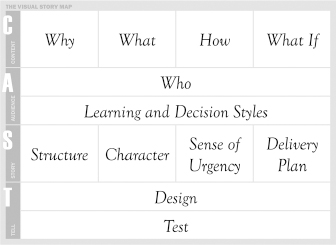The Visual Story Map
The diagram below is called a Visual Story Map. We developed the Visual Story Map to illustrate the process for creating a visual story, and to show how the steps of the process relate to one another. We named the process CAST after the four main steps shown vertically on the far-left side of the Visual Story Map: Content, Audience, Story, and Tell.

CONTENT ROW Many presentations have too much content that is not relevant to the decision or change being proposed. If you want your sales team to search for new customers, or your IT group to implement a new content management system, your content must lead the audience to understand why you want them to act, and what they must do.
AUDIENCE ROW You need to understand the people you're telling your story to. What do they need to know? How can you motivate them to respond in the way you intend? Whether you want your design team to develop a new logo, or your CEO to approve a new project, you need to consider the different people in the audience.
STORY ROW When you are clear about the content and your audience, you can focus on the story structure. We draw from centuries of practical experience of how to tell a compelling and interesting story. Using the format of a story, rather than simply presenting information, makes it easy for your audience to identify with your goals, remember your ideas, and agree with your ...
Get Stories that Move Mountains: Storytelling and Visual Design for Persuasive Presentations now with the O’Reilly learning platform.
O’Reilly members experience books, live events, courses curated by job role, and more from O’Reilly and nearly 200 top publishers.

